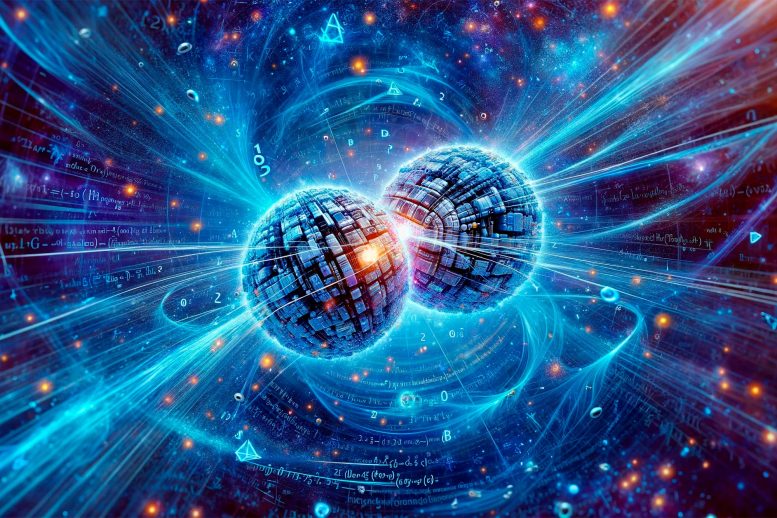
The Large Hadron Collider at CERN can be used to study many kinds of fundamental particles, including mysterious and rare tau particles.
In a breakthrough at CERN, scientists measured the elusive tau particle’s magnetic moment using near-miss particle interactions in the Large Hadron Collider. This method, marking a significant advancement in particle physics, has the potential to reveal unknown aspects of the universe’s fundamental nature.
One way physicists seek clues to unravel the mysteries of the universe is by smashing matter together and inspecting the debris. But these types of destructive experiments, while incredibly informative, have limits.
We are two scientists who study nuclear and particle physics using CERN’s Large Hadron Collider near Geneva, Switzerland. Working with an international group of nuclear and particle physicists, our team realized that hidden in the data from previous studies was a remarkable and innovative experiment.
A Novel Approach to Measuring Particle Wobble
In a new paper published in the journal Physical Review Letters, we developed a new method with our colleagues for measuring how fast a particle called the tau wobbles.
Our novel approach looks at the times incoming particles in the accelerator whiz by each other rather than the times they smash together in head-on collisions. Surprisingly, this approach enables far more accurate measurements of the tau particle’s wobble than previous techniques. This is the first time in nearly 20 years scientists have measured this wobble, known as the tau magnetic moment, and it may help illuminate tantalizing cracks emerging in the known laws of physics.
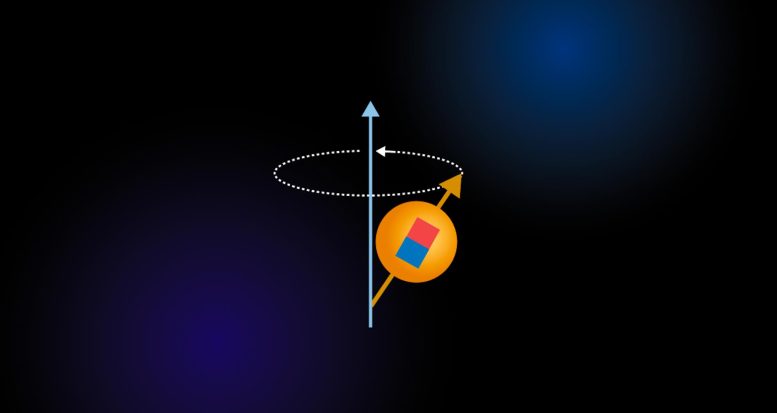
Electrons, muons, and taus all wobble in a magnetic field like a spinning top. Measuring the wobbling speed can provide clues into quantum physics. Credit: Jesse Liu, CC BY-ND
Why Measure a Wobble?
Electrons, the building blocks of atoms, have two heavier cousins called the muon and the tau. Taus are the heaviest in this family of three and the most mysterious, as they exist only for minuscule amounts of time.
Interestingly, when you place an electron, muon or tau inside a magnetic field, these particles wobble in a manner similar to how a spinning top wobbles on a table. This wobble is called a particle’s magnetic moment. It is possible to predict how fast these particles should wobble using the Standard Model of particle physics – scientists’ best theory of how particles interact.
Since the 1940s, physicists have been interested in measuring magnetic moments to reveal intriguing effects in the quantum world. According to quantum physics, clouds of particles and antiparticles are constantly popping in and out of existence. These fleeting fluctuations slightly alter how fast electrons, muons and taus wobble inside a magnetic field. By measuring this wobble very precisely, physicists can peer into this cloud to uncover possible hints of undiscovered particles.
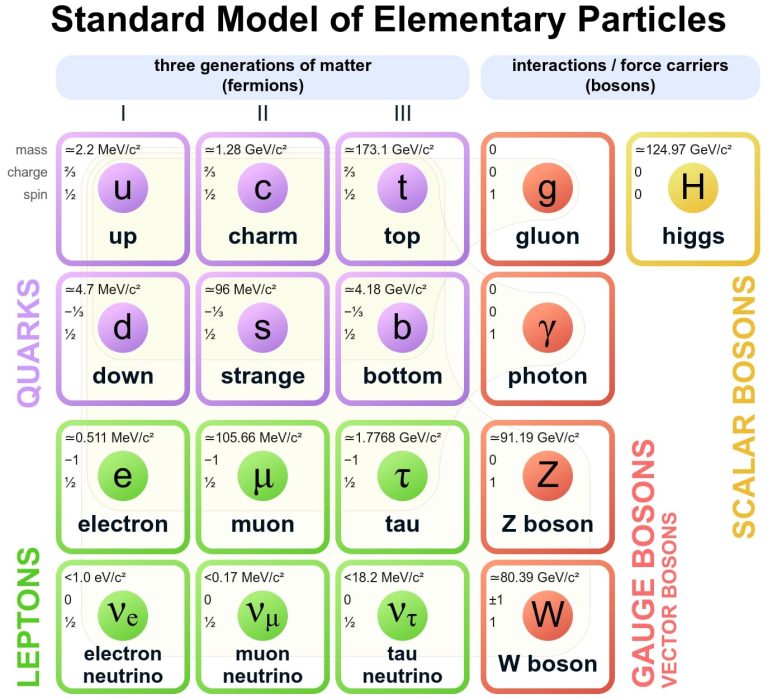
Electrons, muons and taus are three closely related particles in the Standard Model of particle physics – scientists’ current best description of the fundamental laws of nature. Credit: MissMJ/WikimediaCommons
Testing Electrons, Muons and Taus
In 1948, theoretical physicist Julian Schwinger first calculated how the quantum cloud alters the electron’s magnetic moment. Since then, experimental physicists have measured the speed of the electron’s wobble to an extraordinary 13 decimal places.
The heavier the particle, the more its wobble will change because of undiscovered new particles lurking in its quantum cloud. Since electrons are so light, this limits their sensitivity to new particles.
Muons and taus are much heavier but also far shorter-lived than electrons. While muons exist only for mere microseconds, scientists at Fermilab near Chicago measured the muon’s magnetic moment to 10 decimal places in 2021. They found that muons wobbled noticeably faster than Standard Model predictions, suggesting unknown particles may be appearing in the muon’s quantum cloud.
Taus are the heaviest particle of the family – 17 times more massive than a muon and 3,500 times heavier than an electron. This makes them much more sensitive to potentially undiscovered particles in the quantum clouds. But taus are also the hardest to see, since they live for just a millionth of the time a muon exists.
To date, the best measurement of the tau’s magnetic moment was made in 2004 using a now-retired electron collider at CERN. Though an incredible scientific feat, after multiple years of collecting data that experiment could measure the speed of the tau’s wobble to only two decimal places. Unfortunately, to test the Standard Model, physicists would need a measurement 10 times as precise.
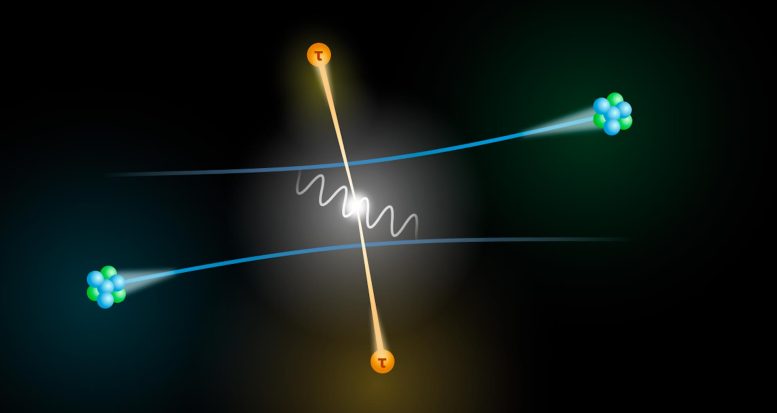
Instead of colliding two nuclei head-on to create tau particles, two lead ions can whiz past each other in a near miss and still produce taus. Credit: Jesse Liu, CC BY-ND
Lead Ions for Near-Miss Physics
Since the 2004 measurement of the tau’s magenetic moment, physicists have been seeking new ways to measure the tau wobble.
The Large Hadron Collider usually smashes the nuclei of two atoms together – that is why it is called a collider. These head-on collisions create a fireworks display of debris that can include taus, but the noisy conditions preclude careful measurements of the tau’s magnetic moment.
From 2015 to 2018, there was an experiment at CERN that was designed primarily to allow nuclear physicists to study exotic hot matter created in head-on collisions. The particles used in this experiment were lead nuclei that had been stripped of their electrons – called lead ions. Lead ions are electrically charged and produce strong electromagnetic fields.
The electromagnetic fields of lead ions contain particles of light called photons. When two lead ions collide, their photons can also collide and convert all their energy into a single pair of particles. It was these photon collisions that scientists used to measure muons.
These lead ion experiments ended in 2018, but it wasn’t until 2019 that one of us, Jesse Liu, teamed up with particle physicist Lydia Beresford in Oxford, England, and realized the data from the same lead ion experiments could potentially be used to do something new: measure the tau’s magnetic moment.
This discovery was a total surprise. It goes like this: Lead ions are so small that they often miss each other in collision experiments. But occasionally, the ions pass very close to each other without touching. When this happens, their accompanying photons can still smash together while the ions continue flying on their merry way.
These photon collisions can create a variety of particles – like the muons in the previous experiment, and also taus. But without the chaotic fireworks produced by head-on collisions, these near-miss events are far quieter and ideal for measuring traits of the elusive tau.
Much to our excitement, when the team looked back at data from 2018, indeed these lead ion near misses were creating tau particles. There was a new experiment hidden in plain sight!
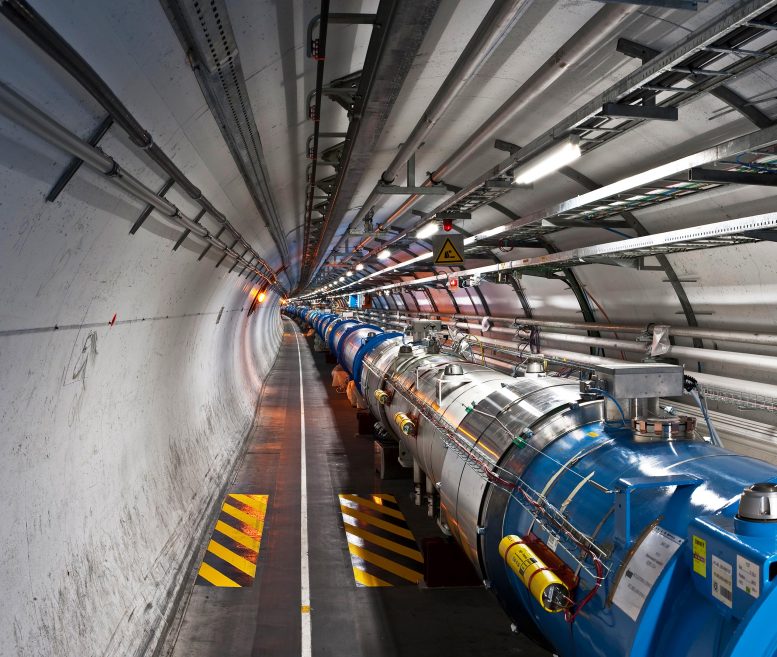
The Large Hadron Collider accelerates particles to incredibly high speeds before trying to smash particles together, but not all attempts result in successful collisions. Credit: Maximilien Brice/CERN
A Landmark Discovery and Future Prospects
In April 2022, the CERN team announced that we had found direct evidence of tau particles created during lead ion near misses. Using that data, the team was also able to measure the tau magnetic moment – the first time such a measurement had been done since 2004. The final results were published on Oct. 12, 2023.
This landmark result measured the tau wobble to two decimal places. Much to our astonishment, this method tied the previous best measurement using only one month of data recorded in 2018.
After no experimental progress for nearly 20 years, this result opens an entirely new and important path toward the tenfold improvement in precision needed to test Standard Model predictions. Excitingly, more data is on the horizon.
The Large Hadron Collider just restarted lead ion data collection on September 28, 2023, after routine maintenance and upgrades. Our team plans to quadruple the sample size of lead ion near-miss data by 2025. This increase in data will double the accuracy of the measurement of the tau magnetic moment, and improvements to analysis methods may go even further.
Tau particles are one of physicists’ best windows to the enigmatic quantum world, and we are excited for surprises that upcoming results may reveal about the fundamental nature of the universe.
Written by
- Jesse Liu – Research Fellow in Physics, University of Cambridge
- Dennis V. Perepelitsa – Associate Professor of Physics, University of Colorado Boulder
Adapted from an article originally published in The Conversation.![]()


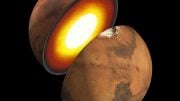
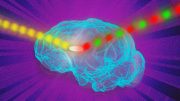
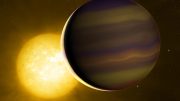
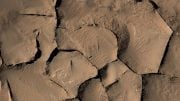
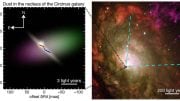

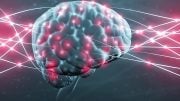
Those who value life on earth are not interested in your billion dollar dangerous atomic research that risks destroying the earth while people suffer from poverty. I have been given authority to tell you to stop your atom gambling in our sacred garden. Nothing could be more sacrilegious than playing billiards with dangerous atoms and unraveling the fundamental structure of creation for no useful value to humanity. God is watching and your days of risking the planet for your empty science are over.
Most science is not based on offending biblical belief. A new proposal of experiment is on my mind for the collider, having more than one collision, have multiple collisions in the same vessel.